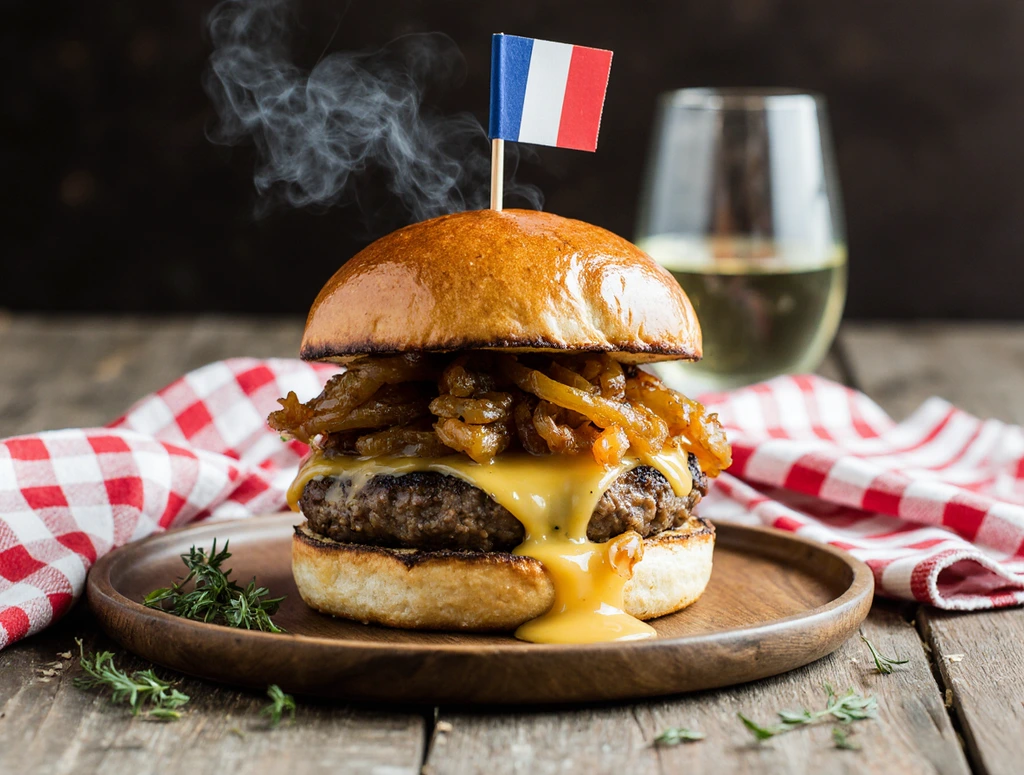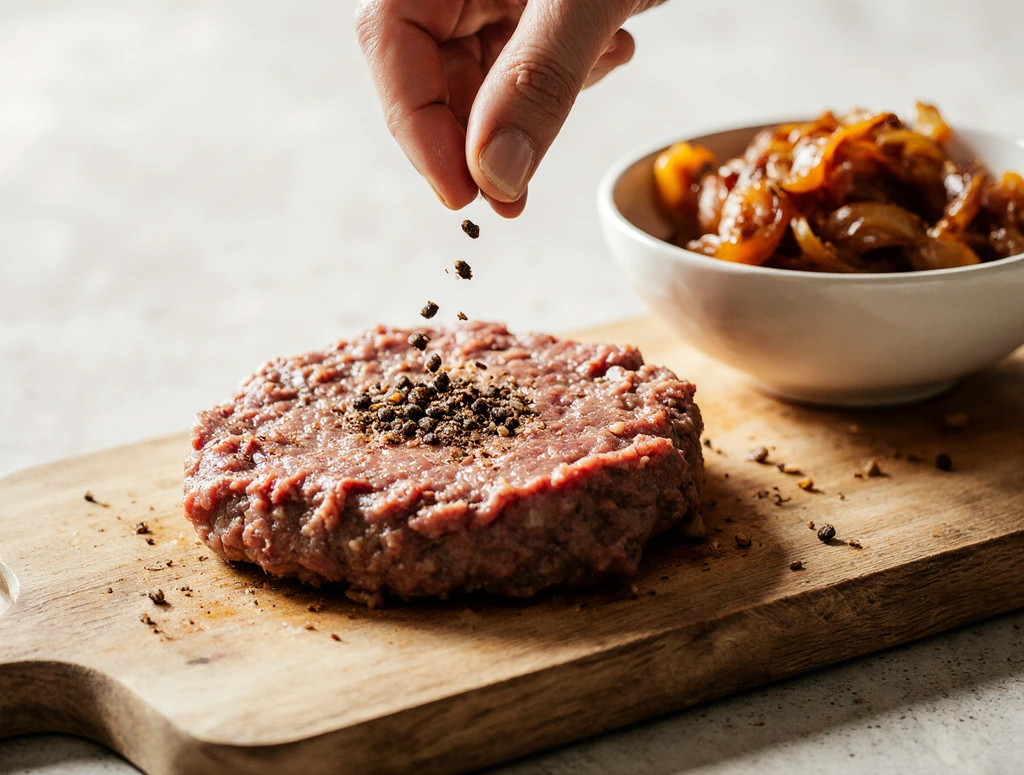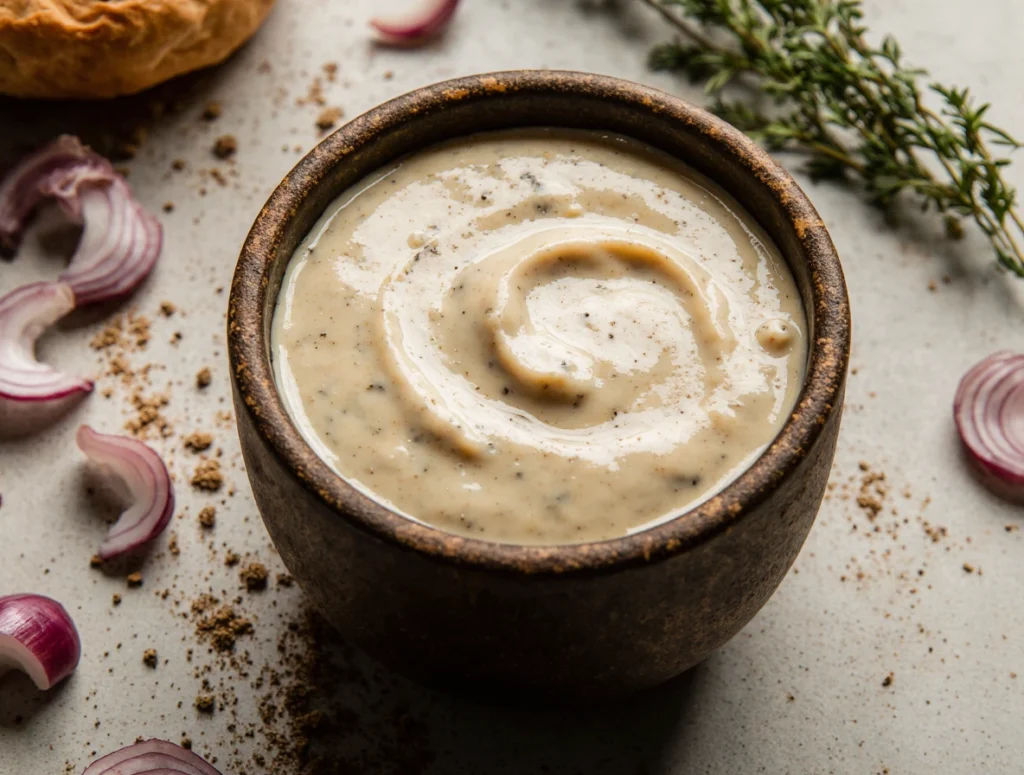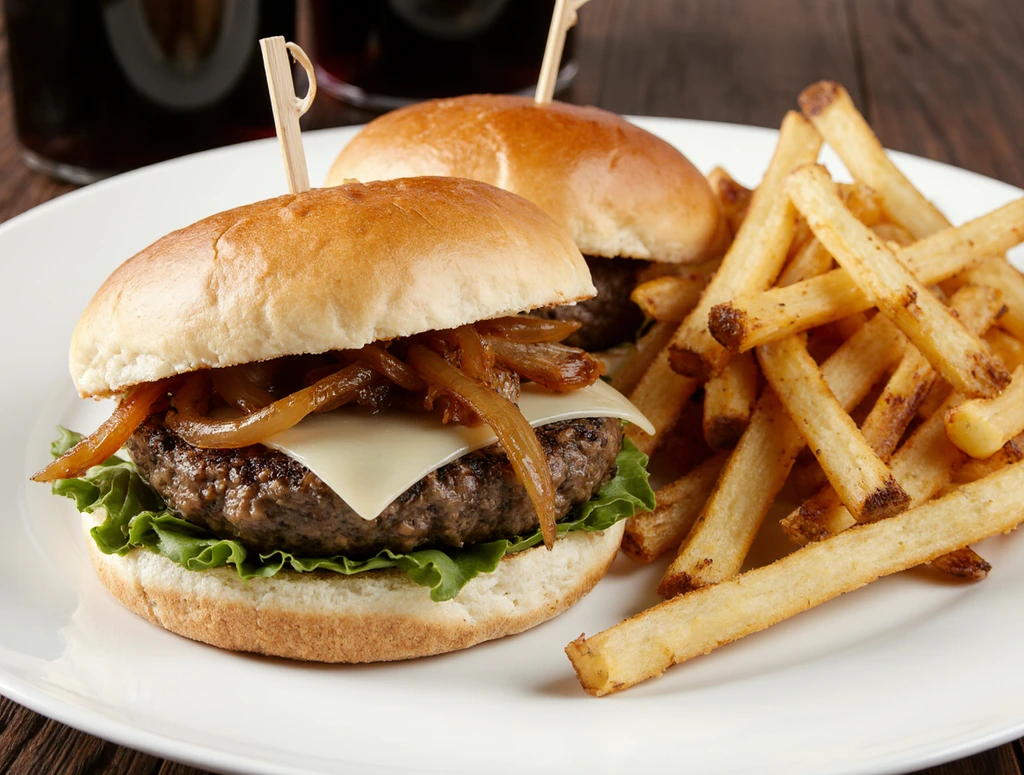
How to Make Homemade French Onion Burgers Step by Step
By Chef HAMZA | TheFoodNearMe
Picture this: the rich, savoury aroma of perfectly caramelized onions mingling with sizzling beef, topped with melting Gruyère cheese that stretches as you take that first magnificent bite. Homemade French onion burgers aren’t just a meal—they’re a culinary experience that transforms your kitchen into a gourmet bistro.
After 28 years behind the stove, I’ve perfected this recipe that combines the soul-warming essence of French onion soup with the irresistible satisfaction of a perfectly crafted burger. This isn’t your typical backyard barbecue fare; it’s an elevated comfort food masterpiece that’ll have your family begging for the recipe.
In this comprehensive guide, I’ll walk you through every technique, from achieving those golden-brown caramelized onions to selecting the perfect cheese blend. Whether you’re a weekend warrior in the kitchen or a seasoned home cook, you’ll master the art of creating restaurant-quality French onion burgers that rival any steakhouse.
What Makes French Onion Burgers Special?
The magic of homemade French onion burgers lies in the perfect harmony of flavours that mirror the beloved French onion soup. Unlike traditional burgers, these beauties feature deeply caramelized onions that have been slowly cooked to golden perfection, creating a sweet and savoury foundation that transforms an ordinary beef patty into something extraordinary.
The key components that set these burgers apart include the long, slow caramelization process that develops complex flavours, the choice of premium cheese (traditionally Gruyère), and the careful balance of seasonings that complement rather than overpower the star ingredients. When done correctly, each bite delivers layers of flavour: the umami-rich beef, the sweet depth of caramelized onions, and the nutty melted cheese create a symphony in your mouth.
What truly makes these burgers special is their versatility. They work equally well as an elegant dinner party centrepiece or a cosy weeknight family meal. The technique I’m sharing today ensures consistent results every time, turning what might seem like an intimidating restaurant dish into an approachable home cooking triumph.
Essential Ingredients for Perfect French Onion Burgers
The Foundation: Quality Ground Beef
The heart of any great burger starts with excellent beef. For French onion smash burgers or traditional thick patties, I recommend using ground chuck with an 80/20 fat ratio. This provides the perfect balance of flavour and juiciness without being overly greasy. Avoid lean ground beef—the fat content is crucial for taste and texture.
Look for freshly ground beef from your butcher, or choose packages with the most recent grinding date. The meat should be bright red with visible marbling of white fat throughout. Avoid pre-formed patties; shaping them yourself ensures better texture and flavour distribution.
The Star: Caramelized Onions
Caramelized onions for burgers require patience and the right variety. Yellow onions are my go-to choice because they have the perfect balance of sweetness and sharpness. Sweet onions like Vidalia work beautifully, too, though they’ll create a milder flavour profile.
You’ll need about 3-4 large onions for a batch of six burgers. The key is slicing them uniformly—about ¼-inch thick—to ensure even cooking. Too thin and they’ll burn before caramelizing; too thick and they won’t break down properly.
The Cheese: Gruyère and Beyond
Traditional French onion soup calls for Gruyère cheese and good reason. This gruyere burger recipe celebrates the cheese’s complex, nutty flavour that pairs beautifully with caramelized onions. Gruyère melts smoothly and adds a sophisticated depth that regular American cheese can’t match.
Alternative cheese options include:
- Swiss cheese for a milder, similar flavour
- Aged white cheddar for sharper notes
- Comté for an even more complex French experience
- Provolone for a slightly different but delicious twist
The Vessel: Choosing the Right Buns
Best burger buns for French onion burgers should complement, not compete with, the rich flavours. Brioche buns are my top choice—their buttery richness and soft texture provide the perfect canvas. The slight sweetness balances the savoury elements beautifully.
Other excellent options include:
- Pretzel buns for added salt and chew
- Onion rolls to double down on the onion theme
- Kaiser rolls for a more traditional approach.
- Artisan hamburger buns for a rustic feel
Step-by-Step Guide to Perfect Caramelized Onions
The Science Behind Caramelization
Caramelizing onions is a process of transformation that can’t be rushed. When onions are simmered over low heat, their natural sugars break down and develop complex flavours through the Maillard reaction. This process typically takes 45-60 minutes and requires patience, but the results are worth every minute.
The key is maintaining low, consistent heat. Too high, and the onions will burn before caramelizing. Too low, and they’ll dry out without developing colour. Sweet spots vary by stove, but medium-low heat is usually perfect.
Technique for Golden Perfection
Start with 3-4 large yellow onions, sliced into uniform ¼-inch pieces. Heat 2 tablespoons of butter and one tablespoon of neutral oil in a large, heavy-bottomed skillet over medium-low heat. The combination of butter and oil prevents burning while adding rich flavour.
Add the sliced onions with a generous pinch of salt—this helps draw out moisture and speeds up the initial cooking. Stir gently to coat all onions with the fat. For the first 15 minutes, stir occasionally as the onions release their moisture and begin to soften.
After the initial softening, reduce heat to low and continue cooking, stirring every 5-7 minutes. The onions will gradually turn golden, then deep amber, and finally rich brown. This process takes 45-60 minutes in total. If they start to stick or brown too quickly, add a splash of beef broth or white wine to deglaze the pan.
Troubleshooting Common Issues
If your onions are browning too quickly, reduce the heat immediately and add a tablespoon of liquid to stop the browning process. If they are drying out without caramelizing, add more butter or oil. Properly caramelized onions should be jammy in consistency, deeply coloured, and incredibly fragrant.
You can make caramelized onions up to three days ahead and store them in the refrigerator. Reheat gently before using, adding a splash of broth if they seem dry.
Crafting the Perfect Burger Patty
Seasoning Strategy
The beauty of homemade French onion burgers lies in their simplicity. Season your ground beef generously with salt and freshly cracked black pepper—about one teaspoon of salt and ½ teaspoon of pepper per pound of beef. Some recipes call for incorporating onion soup mix directly into the meat. Still, I prefer letting the caramelized onions provide the onion flavour.
Mix the seasonings gently into the meat, being careful not to overwork it. Overworked ground beef becomes dense and tough. Use your hands and mix just until the seasonings are evenly distributed.

Shaping Techniques
For traditional thick burgers, portion the meat into 6-ounce portions and gently shape it into patties slightly larger than your buns—they’ll shrink during cooking. Create a slight indentation in the centre with your thumb; this prevents the burger from puffing up into a ball during cooking.
For French onion smash burgers, use 3-4 ounce portions and don’t pre-shape them. You’ll form them on the griddle using a sturdy spatula or burger press. This technique creates more surface area for browning and develops incredible flavour.
Cooking Methods Compared
Stovetop homemade French onion burgers offer the most control over temperature and cooking. Use a cast-iron skillet or heavy-bottomed pan over medium-high heat. Cook for 3-4 minutes on the first side without moving them, then flip and cook for another 2-3 minutes for medium doneness.
Grilling works beautifully, too, especially for that smoky flavour. Preheat your grill to medium-high and oil the grates well. Cook for the exact time as the stovetop, but be prepared for potential flare-ups from the beef fat.
The smash burger technique involves placing the meatball on a hot griddle and immediately pressing it down with a spatula for 10-15 seconds. This creates maximum surface contact and incredible crust development. Cook for 2-3 minutes, flip, add cheese, and cook for another 1-2 minutes.
Cheese Selection and Melting Mastery
Why Gruyère Reigns Supreme
Gruyère cheese brings nutty, complex flavours that pair perfectly with caramelized onions. Its excellent melting properties create that glossy, stretchy finish that makes these burgers Instagram-worthy. What cheese for homemade French onion burgers often comes down to personal preference, but Gruyère is the classic choice for a good reason.
When selecting Gruyère, look for aged varieties (6-12 months) for more complex flavours. The cheese should be pale yellow with small holes throughout. Avoid pre-shredded cheese—it contains anti-caking agents that prevent smooth melting.
Alternative Cheese Options
Swiss cheese offers similar characteristics to Gruyère but with a milder flavour and lower price point. It melts beautifully and provides that classic “holey” appearance many associate with French onion soup.
Aged white cheddar brings sharp, tangy notes that complement the sweet onions beautifully. While not traditional, it creates a delicious variation that many prefer. Choose extra-sharp varieties for the best flavour impact.
For a more accessible option, provolone cheese melts well. It has a pleasant, mild flavour that won’t overpower the other ingredients. It’s readily available in most grocery stores and budget-friendly.
Perfect Melting Technique
Add cheese to your burgers during the last minute of cooking. If cooking on a stovetop, cover the pan with a lid to create a steaming effect that melts the cheese evenly. For grilled burgers, move them to a cooler part of the grill and close the lid.
The cheese is perfectly melted when it’s glossy and slightly bubbly around the edges. Avoid overcooking, which can cause the cheese to become oily and separate.
Creating the Ultimate Homemade French onion burgers Sauce
Classic Horseradish Aioli
homemade French onion burgers sauce elevates these burgers from great to extraordinary. My signature sauce combines mayonnaise with prepared horseradish, Dijon mustard, and a touch of Worcestershire sauce. This creates a creamy, tangy complement to the rich onions and cheese.
Mix ½ cup mayonnaise with one tablespoon prepared horseradish, one teaspoon Dijon mustard, ½ teaspoon Worcestershire sauce, and a pinch of garlic powder. Adjust the horseradish to taste—start with less if you’re sensitive to heat.

Caramelized Onion Mayo
For an even more onion-forward approach, blend some of your caramelized onions directly into mayonnaise. This creates a sweet-savoury spread that amplifies the burger’s main flavour profile. Use about two tablespoons of cooled caramelized onions per ½ cup of mayonnaise.
Red Wine Reduction
For a more sophisticated approach, create a red wine reduction by simmering ½ cup red wine with one tablespoon of balsamic vinegar until it reduces to about two tablespoons. This creates an elegant drizzle that adds depth and acidity to cut through the rich ingredients.
Assembly Techniques for Maximum Impact
Bun Selection and Preparation
Best burger buns for French onion burgers should be sturdy enough to hold all the delicious toppings without falling apart. Brioche buns are ideal but toast them lightly to add structure and prevent sogginess.
Brush the cut sides with melted butter and toast in a dry skillet for 1-2 minutes until golden brown. This creates a barrier that prevents the bun from getting soggy while adding a buttery flavour that complements the overall taste profile.
Layering Strategy
Proper assembly ensures every bite contains all the key components. Start with the bottom bun, spread with your chosen sauce, then add lettuce or arugula if using. Place the hot burger patty on top while the cheese is still melting.
Pile the caramelized onions generously on top of the cheese—don’t be shy here. Add any additional toppings like tomato or pickles, then finish with the top bun. The heat from the burger will continue melting the cheese and warming the onions.
Presentation Tips
Let the assembled burger rest for 2-3 minutes before serving. This allows the juices to be redistributed and makes the burger more straightforward to handle. Secure with a toothpick if needed, and serve on warmed plates for the best experience.
Consider wrapping the bottom half in parchment paper or foil for easier handling, especially with juicy burgers. This restaurant technique keeps your hands clean and prevents the burger from falling apart.
Cooking Methods: Stovetop vs. Grill vs. Smash
Stovetop Excellence
Stovetop homemade French onion burgers offer the most control and are perfect for year-round cooking. Use a cast-iron skillet for superior heat retention and even cooking. Preheat the pan over medium-high heat until it’s hot enough that a drop of water sizzles immediately.
The advantage of stovetop cooking is consistent temperature control and the ability to manage both the homemade French onion burgers simultaneously. You can also easily control the melting process by covering the pan during the final moments of cooking.
Grilling Mastery
Grilled homemade French onion burgers develop wonderful smoky flavours that complement the caramelized onions beautifully. Preheat your grill to medium-high heat and clean the grates thoroughly. Oil the grates just before cooking to prevent sticking.
For gas grills, maintain steady heat around 400-450°F. For charcoal, create zones of different heat levels—high for searing and medium for cooking through. Always have a cooler zone available for managing flare-ups or slower cooking if needed.
Smash Burger Technique
How to make homemade French onion burgers smash involves a different approach that maximizes surface area and creates incredible crust. Use a flat-top griddle or large cast-iron skillet heated to medium-high heat.
Form 3-4 ounce balls of seasoned beef and place them on the hot surface. Immediately press down with a sturdy spatula for 10-15 seconds, creating maximum contact with the cooking surface. This technique develops more Maillard reactions, creating deeper flavours and better texture.
Cook for 2-3 minutes without moving, then flip, add cheese, and cook for another 1-2 minutes. The result is a burger with an incredible crust and juicy interior that pairs beautifully with caramelized onions.
Wine and Beverage Pairings
Classic Wine Pairings
homemade French onion burgers pair beautifully with robust red wines that can stand up to the rich flavours. Côtes du Rhône offers excellent value and complementary flavours, while Burgundy provides elegant earthiness that enhances the Gruyère cheese.
For white wine lovers, a rich Chardonnay with some oak ageing complements the buttery elements while providing enough body to match the burger’s intensity. Avoid light, crisp whites that will be overwhelmed by the rich flavours.
Beer Selections
Brown ales and porters work wonderfully with homemade French onion burgers, their roasted malt flavours echoing the caramelized onions’ depth. Belgian dubbels offer fruity complexity that pairs beautifully with Gruyère cheese.
For lighter options, a well-hopped IPA can cut through the richness while adding complementary bitter notes. German lagers provide a clean, crisp contrast that cleanses the palate between bites.
Non-Alcoholic Options
Sparkling water with lemon provides palate-cleansing effervescence, while ginger beer adds spicy complexity that complements the savoury elements. Coffee or espresso makes an excellent after-dinner pairing, especially with the nutty notes of Gruyère cheese.

Make-Ahead Tips and Meal Prep
Preparing Components in Advance
The beauty of French onion burgers lies in their make-ahead potential. Caramelized onions can be prepared up to three days in advance and stored in the refrigerator. They improve in flavour as they sit, making them perfect for meal prep.
Burger patties can be formed and seasoned up to 24 hours ahead. Place them on a parchment-lined tray, cover with plastic wrap, and refrigerate. Remove from the refrigerator 20-30 minutes before cooking to bring to room temperature.
The burger sauce keeps for up to a week in the refrigerator and improves as the flavours meld. Make a double batch and use it on other sandwiches throughout the week.
Storage and Reheating
Leftover cooked burgers can be refrigerated for up to three days. Reheat gently in a covered skillet over low heat, adding a splash of beef broth to prevent drying out. The cheese may not re-melt perfectly, but the flavours remain delicious.
Caramelized onions freeze beautifully for up to three months. Portion them into ice cube trays for easy single-serving portions, then transfer them to freezer bags once frozen. Thaw overnight in the refrigerator before reheating.
Batch Cooking Strategy
Double or triple the caramelized onion recipe and freeze portions for future use. They’re excellent on steaks, in omelettes, or as pizza toppings. Having them on hand makes weeknighthomemade French onion burgers a quick reality.
Nutritional Information and Dietary Modifications
Calorie Breakdown
A typical homemade French onion burger contains approximately 650-750 calories, depending on bun choice and portion size. The breakdown includes roughly 350-400 calories from the beef patty, 150-200 from the bun, 100-150 from cheese, and additional calories from the caramelized onions and sauce.
For detailed nutritional tracking, consider using our calorie calculator to customize based on your specific ingredients and portions.
Healthier Modifications
Lean ground turkey or chicken can substitute for beef, though you’ll need to add extra fat (like olive oil) to prevent dryness. Turkey maintains protein content while reducing saturated fat and overall calories.
Whole grain buns add fibre and nutrients while providing a nuttier flavour that complements the caramelized onions. Portobello mushroom caps make an excellent low-carb alternative for those following ketogenic diets.
Gluten-Free Adaptations
Use certified gluten-free buns or serve the homemade French onion burgers bunless over a bed of arugula for a naturally gluten-free option. Most cheeses are naturally gluten-free, but always check labels on processed varieties.
Lettuce wraps work beautifully for those avoiding grains entirely. Choose sturdy varieties like butter lettuce or iceberg that can hold the burger’s weight without falling apart.
Common Mistakes and How to Avoid Them
Onion Caramelization Errors
The most common mistake is rushing the caramelization process. Onions that are browned too quickly develop bitter flavours instead of the desired sweetness. Always use low heat and allow adequate time—there are no shortcuts to proper caramelization.
Another frequent error is not using enough onions. What seems like a large amount of raw will cook down significantly. Start with more than you think you need—you can always save extras for other uses.
Burger Patty Problems
Overworking the ground beef creates dense, tough burgers. Mix seasonings gently and handle the meat as little as possible—form patties just before cooking for the best texture.
Not creating an indentation in the centre leads to puffed-up burgers that don’t cook evenly. The slight depression compensates for the meat’s natural tendency to contract and puff during cooking.
Assembly Issues
Adding sauce to the wrong bun side can create sogginess. Always apply sauce to the top bun, which stays drier during assembly. The bottom bun should get any juicy toppings like tomatoes.
Forgetting to rest the assembled burger results in a messy eating experience. A brief 2-3 minute rest allows juices to redistribute and makes handling much easier.
Seasonal Variations and Creative Twists
Autumn Apple Addition
Fall brings opportunities to incorporate seasonal flavours. Thinly sliced Granny Smith apples, lightly sautéed with the homemade French onion burgers during the last 10 minutes of caramelization, add crisp texture and complementary sweetness.
A drizzle of apple cider reduction creates an elegant finishing touch that celebrates autumn flavours while maintaining the homemade French onion burgers essence.
Spring Herb Enhancement
Fresh thyme or rosemary mixed into the caramelized onions adds aromatic complexity, perfect for spring. Use herbs sparingly—about one teaspoon of fresh leaves per batch of onions—to avoid overwhelming the delicate balance.
Asparagus spears, lightly grilled and placed on top of the cheese, add colour and seasonal flair while providing a textural contrast to the soft onions.
Winter Mushroom Medley
Sautéed mushrooms alongside the caramelized onions create an earthier, more substantial homemade French onion burgers perfect for cold weather. Use a mix of varieties like cremini, shiitake, and oyster mushrooms for complex flavours and textures.
A touch of fresh thyme and a splash of dry sherry during the cooking process elevate this variation to restaurant-quality sophistication.
Troubleshooting Guide
When Onions Won’t Caramelize
If your onions seem stuck in the translucent stage, increase the heat slightly and add a pinch of sugar to jumpstart the caramelization process. Sometimes, adding a splash of white wine or broth helps move things along.
Ensure your pan is large enough—overcrowded homemade French onion burgers steam rather than caramelize. Use the largest skillet you have, or cook in batches if necessary.
Dry Burger Solutions
If your burgers turn out dry, the issue usually stems from lean meat or overcooking. Always use ground beef with at least 20% fat content, and cook to medium doneness at most.
Adding moisture back to cooked burgers is challenging. Still, a light brush of beef broth and gentle reheating in a covered pan can help restore some juiciness.
Cheese Not Melting Properly
Pre-shredded cheese often contains anti-caking agents that prevent smooth melting. Always grate your cheese from a block for the best results.
If cheese isn’t melting evenly, cover the pan with a lid during the last minute of cooking to create a steaming environment that promotes even melting.
Equipment Recommendations
Essential Cookware
A heavy-bottomed skillet, preferably cast iron, is crucial for even heat distribution during both onion caramelization and burger cooking. Cast iron retains heat beautifully and develops excellent searing properties over time.
A large, wide skillet allows onions to cook in a single layer, promoting even caramelization. Avoid non-stick pans for this application—they don’t develop the same depth of flavour that traditional cookware provides.
Helpful Tools
A sturdy spatula is essential for proper burger handling. Look for one with a thin edge that slides easily under delicate patties without breaking them apart.
An instant-read thermometer takes the guesswork out of doneness. Ground beef should reach 160°F internal temperature for food safety, though many prefer the texture at 155°F.
Nice-to-Have Additions
A mandoline slicer creates perfectly uniform onion slices that caramelize evenly. While not essential, it does improve consistency and presentation.
A burger press helps create uniform patties and the signature indentation that prevents puffing. However, gentle hand-shaping works just as well with practice.
Quick Takeaways
- Perfect caramelization takes time: Allow 45-60 minutes for properly caramelized onions—there are no shortcuts to developing complex flavours.
- Quality beef matters: Choose ground chuck with an 80/20 fat ratio for the juiciest, most flavorful burgers
- Gruyère is worth the investment: Its nutty complexity and superior melting properties make it the ideal cheese choice.
- Toast your buns: Lightly buttered and toasted buns prevent sogginess and add extra flavour.
- Don’t rush the process: From caramelizing onions to resting the finished burger, patience creates better results.
- Make components ahead: Caramelized onions and sauce can be prepared days in advance for easier weeknight cooking.
- Temperature control is key: Low heat for onions and medium-high for burgers ensures perfect results every time.
Conclusion
Creating perfect homemade French onion burgers is genuinely an art form that combines patience, technique, and quality ingredients. After walking through every step of this process—from the slow caramelization of onions to the perfect melt of Gruyère cheese—you now have all the tools needed to create restaurant-quality burgers in your kitchen.
These aren’t just any burgers; they’re a celebration of flavour that transforms simple ingredients into something extraordinary. The combination of sweet, jammy caramelized onions, nutty melted cheese, and perfectly seasoned beef creates a symphony of taste that will have your family and friends asking for this recipe again and again.
Remember, the key to success lies in not rushing the process. Good caramelized onions take time, quality ingredients make a difference, and proper technique ensures consistent results. Whether you choose the classic stovetop method, fire up the grill, or try your hand at the smash burger technique, the fundamental principles remain the same.
I encourage you to make this recipe your own by experimenting with different cheese combinations, trying seasonal variations, or developing your signature burger sauce—the beauty of cooking lies in these personal touches that make each dish uniquely yours.
Ready to create burger magic in your kitchen? Start with a batch of caramelized onions this weekend—you can use them immediately or freeze portions for quick weeknight meals. Share your results in the comments below, and don’t forget to tag @TheFoodNearMe on social media with your beautiful burger creations!
Frequently Asked Questions
How long do caramelized homemade French onion burger stake to make?
Properly caramelized onions take 45-60 minutes of slow cooking over low heat. While some recipes claim faster methods, proper caramelization requires time for the onions’ natural sugars to develop complex flavours through the Maillard reaction.
Can I substitute Swiss cheese for Gruyère in this recipe?
Absolutely! Swiss cheese is an excellent substitute that provides similar melting properties and nutty flavours. While Gruyère offers more complexity, Swiss cheese is more budget-friendly and widely available while still delivering delicious results.
What’s the best way to store leftover caramelized onions?
Store cooled caramelized onions in an airtight container in the refrigerator for up to 3 days, or freeze in portions for up to 3 months. Ice cube trays work great for portioning—transfer to freezer bags once frozen solid.
Can I make these homemade French onion burgers on a regular George Foreman grill?
While possible, contact grills like George Foreman models don’t provide the best results for French onion burgers. The caramelized onions can fall off, and you lose control over the cheese melting. Stovetop or traditional grilling methods work much better.
How can I prevent my burger buns from getting soggy?
Toast the buns lightly with butter to create a moisture barrier, apply sauce to the top bun rather than the bottom, and let the assembled burger rest for 2-3 minutes before serving. These simple steps prevent sogginess while maintaining flavour.
What’s your favourite twist on classic French onion burgers? Have you tried any creative cheese combinations or seasonal variations? Share your experiences and photos in the comments below—I read every single one and love seeing your culinary creativity in action!
Don’t forget to subscribe to TheFoodNearMe for more gourmet burger recipes and cooking techniques that bring restaurant-quality flavours to your home kitchen. Happy cooking!
Chef HAMZA
Founder, TheFoodNearMe
